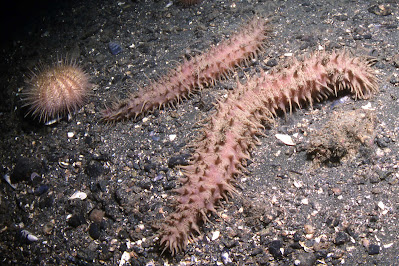[Most Recent Entries] [Calendar View]
Friday, May 30th, 2025
| Time | Event | ||||
| 6:06a | [Invertebrate • 2024] Synallactes mcdanieli • A New Species of Sea Cucumber (Holothuroidea: Synallactida) from British Columbia, Canada and the Gulf of Alaska, USA
Abstract Background: The family Synallactidae comprises mostly deep-sea forms and is the least-studied large taxon amongst deep-sea cucumbers. They are part of the abyssal megafauna and play an important role in modifying the sediment landscape and structuring the communities that live within it. The family embraces the genus Synallactes, which contains approximately twenty-five species from the Pacific, Atlantic (six species), Indian (seven species) and Antarctic Oceans (one species). New information: Synallactes mcdanieli sp. nov. is described from the Northeast Pacific, Knight Inlet, British Columbia, Canada to Kodiak Island, Gulf of Alaska, USA, at depths from 21 to 438 m. This new species is unique amongst the species of the genus Synallactes because of the number and arrangement of dorsal papillae, number of Polian vesicles, together with the entire ossicle arrangement. In addition, this species has the shallowest bathymetric distribution ever recorded for this genus. Keywords: Synallactidae, taxonomy, Northeast Pacific
Francisco A Solís Marín, Andrea A Caballero Ochoa and Carlos A Conejeros-Vargas. 2024. Synallactes mcdanieli sp. nov., A New Species of Sea Cucumber from British Columbia, Canada and the Gulf of Alaska, USA (Holothuroidea, Synallactida). Biodiversity Data Journal. 12: e124603. DOI: doi.org/10.3897/BDJ.12.e124603 | ||||
| 6:34a | [PaleoOrnithology • 2025] Arctic Bird Nesting traces back to the Cretaceous
Abstract Polar ecosystems are structured and enriched by birds, which nest there seasonally and serve as keystone ecosystem members. Despite the ecological importance of polar birds, the origins of high-latitude nesting strategies remain obscured by a sparse fossil record. We report an extreme-latitude Arctic avialan assemblage from the Prince Creek Formation of Alaska—the northernmost Late Cretaceous terrestrial ecosystem. Numerous three-dimensionally preserved fossils constitute one of the most taxonomically rich Late Cretaceous avialan assemblages, including members of Hesperornithes, Ichthyornithes, and near-crown or crown birds (Neornithes), recording a previously undocumented interval in avialan evolution. Abundant perinatal fossils represent the oldest evidence of birds nesting at polar latitudes, which demonstrates that birds began using seasonal polar environments for breeding during the Cretaceous, long before their modern descendants. Lauren N. Wilson, Daniel T. Ksepka, John P. Wilson, Jacob D. Gardner, Gregory M. Erickson, Donald Brinkman, Caleb M. Brown, Jaelyn J. Eberle, Chris L. Organ and Patrick S. Druckenmiller. 2025. Arctic Bird Nesting traces back to the Cretaceous. Science. 388(6750); 974-978. DOI: doi.org/10.1126/science.adt5189 [29 May 2025] Editor’s summary: In the modern world, birds represent key components of polar ecosystems. This is true even in the face of the extreme seasonal changes that occur in these regions. Although the Cretaceous world was considerably warmer than ours, the polar regions still experienced months of near total darkness, suggesting that this was a challenging environment to colonize even when it didn’t experience extreme cold. Wilson et al. report on a fossil assemblage of birds from the late Cretaceous Arctic. This assemblage includes both chicks and adults of multiple species, suggesting that birds began breeding in Arctic regions early on in their evolution. —Sacha Vignieri |
| << Previous Day |
2025/05/30 [Calendar] |
Next Day >> |





